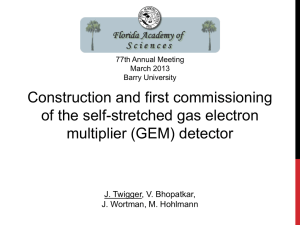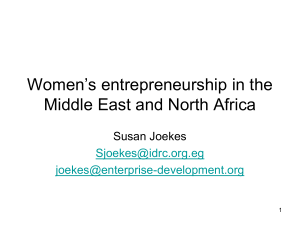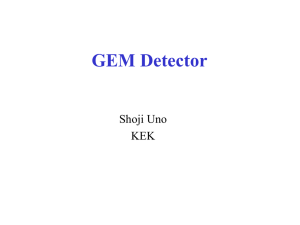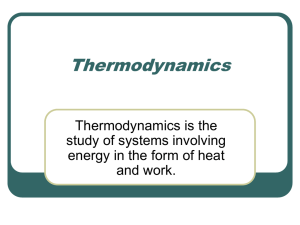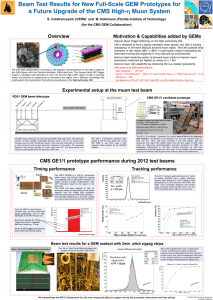Digital Hadron Calorimetry for the Linear Collider using GEM based
advertisement
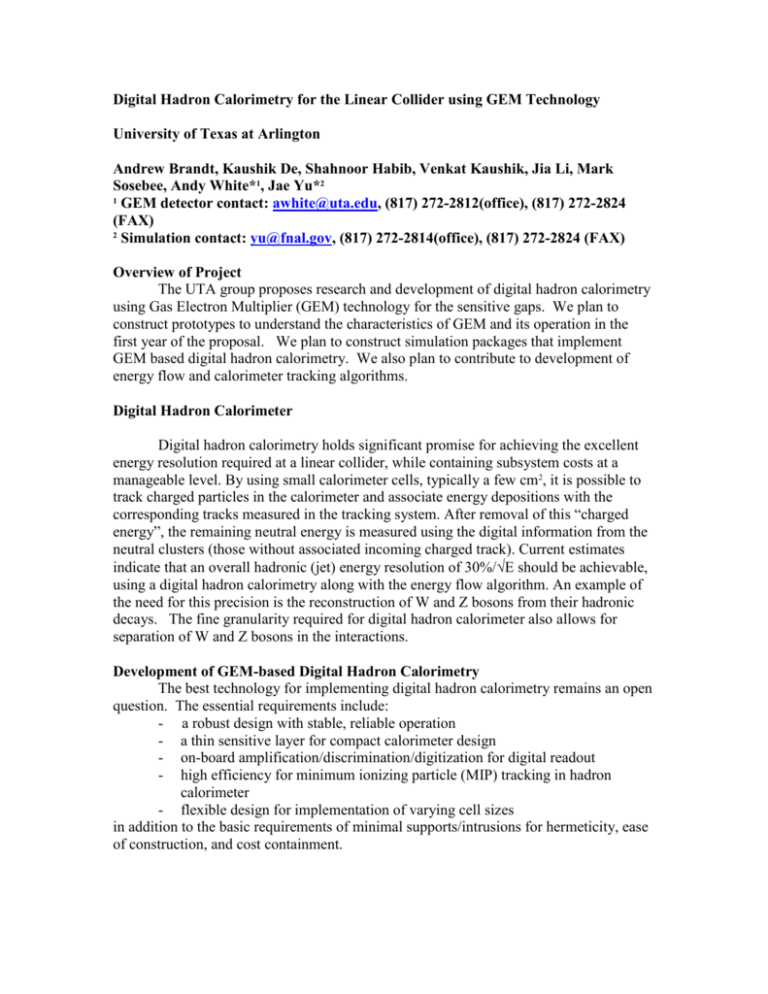
Digital Hadron Calorimetry for the Linear Collider using GEM Technology University of Texas at Arlington Andrew Brandt, Kaushik De, Shahnoor Habib, Venkat Kaushik, Jia Li, Mark Sosebee, Andy White*1, Jae Yu*2 1 GEM detector contact: awhite@uta.edu, (817) 272-2812(office), (817) 272-2824 (FAX) 2 Simulation contact: yu@fnal.gov, (817) 272-2814(office), (817) 272-2824 (FAX) Overview of Project The UTA group proposes research and development of digital hadron calorimetry using Gas Electron Multiplier (GEM) technology for the sensitive gaps. We plan to construct prototypes to understand the characteristics of GEM and its operation in the first year of the proposal. We plan to construct simulation packages that implement GEM based digital hadron calorimetry. We also plan to contribute to development of energy flow and calorimeter tracking algorithms. Digital Hadron Calorimeter Digital hadron calorimetry holds significant promise for achieving the excellent energy resolution required at a linear collider, while containing subsystem costs at a manageable level. By using small calorimeter cells, typically a few cm2, it is possible to track charged particles in the calorimeter and associate energy depositions with the corresponding tracks measured in the tracking system. After removal of this “charged energy”, the remaining neutral energy is measured using the digital information from the neutral clusters (those without associated incoming charged track). Current estimates indicate that an overall hadronic (jet) energy resolution of 30%/E should be achievable, using a digital hadron calorimetry along with the energy flow algorithm. An example of the need for this precision is the reconstruction of W and Z bosons from their hadronic decays. The fine granularity required for digital hadron calorimeter also allows for separation of W and Z bosons in the interactions. Development of GEM-based Digital Hadron Calorimetry The best technology for implementing digital hadron calorimetry remains an open question. The essential requirements include: - a robust design with stable, reliable operation - a thin sensitive layer for compact calorimeter design - on-board amplification/discrimination/digitization for digital readout - high efficiency for minimum ionizing particle (MIP) tracking in hadron calorimeter - flexible design for implementation of varying cell sizes in addition to the basic requirements of minimal supports/intrusions for hermeticity, ease of construction, and cost containment. Figure 1. A schematic diagram of a digital hadron calorimeter using triple GEM sampling layers To satisfy these requirements we are exploring an implementation based on the Gas Electron Multiplier (GEM) technology developed at CERN by Fabio Sauli and the GDD Group. As shown in the schematic in Figure 1, GEM active layers are alternated with layers of absorber to form a sampling calorimeter. The GEM layer is 6mm thick with a small amount of space for an electronics layer containing a charge amplifier, discriminator, and register. It may be useful to have two levels of discrimination – one for tracking single MIPs, and one for multiple tracks. The GEM approach allows great flexibility in the cell design; limited only by the cost of the readout, a large range of sizes is possible from microstrips through macroscopic pads. This would allow, for instance, the inclusion of a number of precision layers in the calorimeter stack if it proved useful, for example for muon tracking. One can also imagine that future improvements to a significantly finer granularity by implementing finer readout pads ganged, initially, to a larger pad sizes.We have begun work on a first GEM prototype to give us construction and operational experience with this technology. Figure 2 shows a drawing of the first prototype. The first set of GEM foils is being purchased from the GDD group at CERN. This prototype can be configured as a single, double, or triple GEM detector. It will allow us to understand the signal characteristics and dependence on the potential differences across the drift, transfer, and induction gaps of the GEM, and the signal characteristics from discharges. Subsequently, we plan to design and build prototype GEM calorimeter modules with appropriate designs for signal readout with noise shielding, module-to-module interconnections for power in and signals out, and spacers between large GEM foils. This will also require us to develop our own techniques for producing GEM foils of the size needed for calorimetry, with an eye towards future mass production of foils. Finally, after successful operation of prototype modules, we will design and build a calorimeter stack for trials with cosmic rays and in a test beam. Figure 2. Schematic diagrams of the UTA GEM prototype test box Detector Simulation and Algorithm Development The UTA group is in the process of setting up various Monte Carlo generator tools for detailed studies of digital hadron calorimetry. Among many issues that need to be addressed and studied in depth, the most urgent and important issue is the discharge characteristics of the GEM detectors. Since the digital hadron calorimeter we plan to employ consists of multiple GEM layers to increase gain, it is crucial for us to understand what the expected ion-electron pair density is for high energy, multi-jet events, such as WW or ZZ 4jets, resulting from e+e- collisions at various center-of-mass (CMS) energies. Since this study does not depend on the detailed detector geometry, other than the absorber material and the sensitive gap sizes, we plan to initially work with the SLAC team to use the events that have been generated for Linear Collider studies. In the mean time, in order to perform more realistic and detailed studies, we will implement GEM geometry for prototypes to be built at UTA. Upon the success of the prototype geometry, we will expand the geometry to replace the existing sensitive gaps for larger scale studies in energy flow and calorimeter tracking algorithms. An example of the detailed studies is the use of spacers to minimize fake signals caused by low energy electrons spiraling down the sensitive gas gap. Since the resolution enhancement of digital hadron calorimeters will only work when assisted by a well-developed energy flow algorithm, development of such algorithms is going to be another focus of our efforts. The primary issues we will concentrate on are: - Optimal granularity of the readout cells to keep the linearity of the calorimeter response and to allow efficient removal of the showers associated with charged hadrons - Sampling fraction for optimal energy resolution - Charged track and calorimeter shower matching for shower removal - Dependence of the energy resolution and linearity on electromagnetic fraction of the jet - Determination of thresholds for optimal noise reduction and occupancy, retaining minimum ionizing particle signal identification. - Impact of mechanical support structures for GEM layers and spacers - Optimal spacer distances to minimize fake signal without degrading energy or position resolution Undoubtedly, development of optimal energy flow and calorimeter tracking algorithms will take time and will continue beyond the first year of the project. Future Plans In the subsequent years, we plan to construct a multiple layer digital hadron calorimeter module and to take cosmic ray data to understand the operation and responses of the detector. We also plan to expose the module in a test beam. We anticipate that the simulation package and algorithm development will continue through the subsequent years, along with cosmic ray and test beam data analyses. Facilities and Resources The UTA High Energy Physics group has a 10,000 sq. ft. detector development facility which has recently been used to produce the Intermediate Tile Calorimeter for ATLAS, and to build the upgrade Intercryostat Detector, and Forward Proton Detector for D0. We also have high-grade clean rooms at our NanoFabrication facility. For simulation work we have a farm of 50 processors and anticipate substantially greater computing resources in the near future. Budget During the first year we anticipate building the first GEM prototype, investigating GEM foil production locally, and building one or more prototype GEM calorimeter layer module. We are therefore requesting support for the items listed in Table 1 during the first year. For the second and third years, when construction and testing of a medium sized calorimeter stack for cosmic ray testing and for test beam will occur, we anticipate needing support of $100,000 per year. Table 1. Detailed cost estimate for the first year GEM prototype project Item Materials and workshop time for first prototype and GEM calorimeter layer prototype Charge preamplifier units ADC for signal characterization Gas system Trigger scintillators, PMT’s and electronics Investigation of GEM foil production, trials with local industry PC for data collection Travel to LC calorimeter meetings and workshop(s) Total Cost Estimate $25,000 $6,000 $3,500 $2,500 $4,000 $5,000 $1,000 $5,000 $52,000

